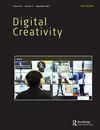思维空间的艺术——一个充满数据的空间
IF 1.3
4区 艺术学
0 ART
引用次数: 2
摘要
互动媒体艺术是一种将数字信息转化为参与过程美学的艺术形式。在他们的艺术研究中,艺术家和建筑师Fleischmann和Strauss专注于“思考空间”(Denkraum)的概念。继Aby Warburg的“思想空间”(1929)之后,他们将互动媒体艺术的思考空间定义为“充满数据的空间”(Strauss, W., and M. Fleischmann, 2001)。艺术家的思考空间是对互动架构的艺术探索,“在模拟文化中唤起”交流(Turkle, S. 2004)。让人们以表演的方式参与进来。本文介绍了他们的三个项目,都是基于思维空间的隐喻:“语义地图”,“媒体流”和“能量通道”说明了使用人工智能来“加强人类智能”的互动策略。问题不在于机器是否会思考,而在于当一切都是自动化的时候,人们是否还能思考。本文章由计算机程序翻译,如有差异,请以英文原文为准。
The art of the thinking space—a space filled with data
ABSTRACT Interactive media art is an art form that ‘transforms digital information and translates it into aesthetics of participative processes.’ In their artistic investigations, the artists and architects Fleischmann and Strauss focus on the concept of the ‘thinking space’ [Denkraum]. Following Aby Warburg's ‘space of thought’ (1929), they define the thinking space of interactive media art as a ‘space filled with data’ (Strauss, W., and M. Fleischmann. 2001. The artists’ thinking space is the artistic exploration of an architecture of interactivity that ‘evokes’ communication ‘in a culture of simulation’ (Turkle, S. 2004). by involving people in a performative way. This article presents three of their projects, all based on the metaphor of the thinking space: ‘Semantic Map’, ‘Media Flow’ and ‘Energy Passages’ illustrate strategies of interactivity using artificial intelligence to ‘reinforce human intelligence’. The question is not whether machines can think, but whether people can still think when everything is automated.
求助全文
通过发布文献求助,成功后即可免费获取论文全文。
去求助
来源期刊

DIGITAL CREATIVITY
ART-
CiteScore
3.10
自引率
9.10%
发文量
19
期刊介绍:
Digital Creativity is a major peer-reviewed journal at the intersection of the creative arts, design and digital technologies. It publishes articles of interest to those involved in the practical task and theoretical aspects of making or using digital media in creative disciplines. These include but are not limited to visual arts, interaction design, physical computing and making, computational materials, textile and fashion design, filmmaking and animation, game design, music, dance, drama, architecture and urban design. The following list, while not exhaustive, indicates a range of topics that fall within the scope of the journal: * New insights through the use of digital media in the creative process * The relationships between practice, research and technology * The design and making of digital artefacts and environments * Interaction relationships between digital media and audience / public * Everyday experience with digital design and artwork * Aspects of digital media and storytelling * Theoretical concepts
 求助内容:
求助内容: 应助结果提醒方式:
应助结果提醒方式:


